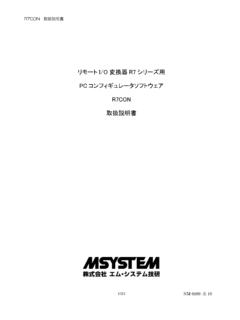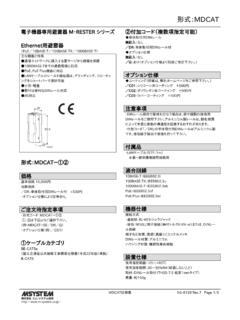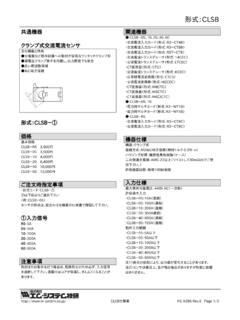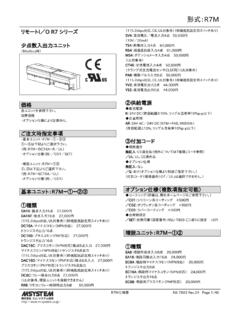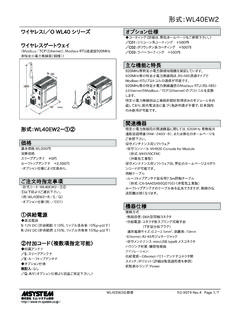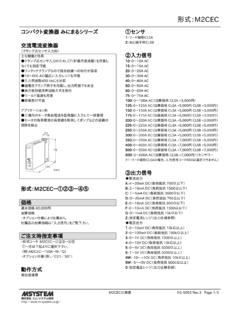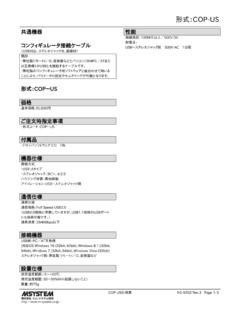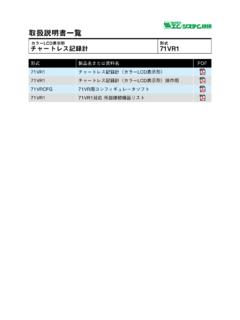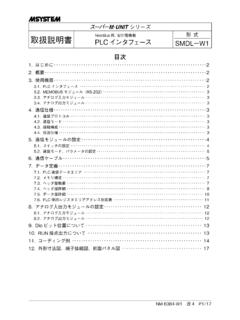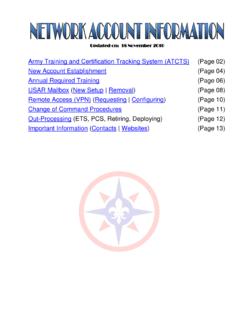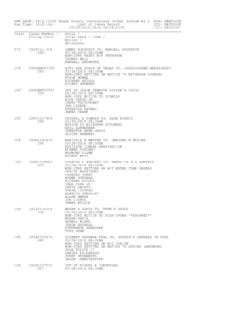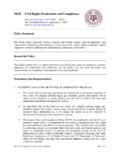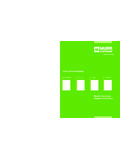Transcription of Modbus Protocol Reference Guide - M-System - …
1 1 Modbus Protocol Reference GuideEM-5650 Protocol Reference GuideContents1. Introduction .. 42. Modbus Protocol .. Description .. Message Framing .. 5 ASCII Framing .. 5 RTU Framing .. 5 Address Field .. 5 Function Field .. 5 Data Field .. 5 Error Checking Field .. 6 LRC Checking .. 6 CRC Checking .. Modbus Function Formats .. 7 Data Address .. 7 Coil .. 7 Input Status .. 7 Input Register .. 7 Holding Register .. Contents in Modbus Messages ..83. Modbus Function Codes .. Coil Status (01) .. Input Status (02) .. Holding Register (03) .. Input Register (04) .. Single Coil (05) .. Single Register (06) .. (08) .. Communication Event Counter (11, 0x0B) .. Communication Event Log (12, 0x0C) .. Force Multiple Coils (15, 0x0F).
2 Multiple Registers (16, 0x10) .. Report Slave ID (17, 0x11) .. 202 Modbus Protocol Reference GuideEM-5650 Diagnostic Subfunctions (08) .. Query Data (00) .. Communications Option (01) .. Diagnostics Register (02) .. Listen Only Mode (04) .. Counters and Diagnostic Register (10, 0x0A) .. Bus Message Count (11, 0x0B) .. Bus Communication Error Count (12, 0x0C) .. Bus Exception Error Count (13, 0x0D) .. Slave Message Count (14, 0x0E) .. Return Slave No Response Count (15, 0x0F) .. Slave Busy Count (17, 0x11) .. Return Bus Character Overrun Count (18, 0x12) .. 225. Exception Responses .. 23 Appendix A.. R1M Series Remote I/O Modbus Communications25A-1 Function Codes .. 25A-2 Data Addresses.
3 25A-3 Input Data .. 26A-4 Coils (DO) Description .. 26DO (1 32) .. 26 Cold Junction Compensation SW (33 48) .. 26A-5 Input Status (DI) Description .. 26DI (10001 10032) ..26 ADC Overrange (10033 10048) .. 26A-6 Input Registers Description .. 27 Analog Input in % (30001 30016) .. 27 Analog Input in Engineering Unit (30017 30048) .. 27 Cold Junction Temperature (30049 30050) .. 27 Channel Status (30081 30096) .. 27 system Status (30513) .. 28 Model No. (30514 30521) .. 28 Serial No. (30522 30529) .. 28 Hardware Version No. (30530 30537) .. 28 Firmware Version No. (30538 30545) .. 28A-7 Holding Registers Description .. 29 Analog Output in % (40001 40016) .. 29 Analog Output in Engineering Unit (40017 40048).
4 29I/O Type No. (40145 40160) .. 293 Modbus Protocol Reference GuideEM-5650 Type (40161 40176) .. 29 Appendix B.. R2M Remote I/O Modbus Communications30B-1 Function Codes .. 30B-2 Data Addresses .. 30B-3 Input Data .. 30B-4 Coils (DO) Description .. 31DO (1 32) .. 31 Cold Junction Compensation SW (33 40) .. 31B-5 Input Status (DI) Description .. 31DI (10001 10032) ..31 ADC Overrange (10033 10040) .. 31B-6 Input Registers Description .. 31 Analog Input in Engineering Unit (30017 30032) .. 31 Cold Junction Temperature (30049 30050) .. 31 Channel Status (30081 30088) .. 31 system Status (30513) .. 32 Model No. (30514 30521) .. 32 Serial No. (30522 30529) .. 32 Hardware Version No. (30530 30537).
5 32 Firmware Version No. (30538 30545) .. 32B-7 Holding Registers Description .. 33 Input Filter Time Constant (40049 40050) .. 33 Input Type No. (40145 40152) .. 33 Burnout Type (40514) .. 33 Appendix C.. Modbus TCP/IP Protocol34C-1 Introduction .. 34C-2 Protocol Layout .. 34C-3 Example .. 35C-4 Point of Caution .. 354 Modbus Protocol Reference GuideEM-5650 Modbus Protocol is provided by Modicon Inc. (AEG Schneider Automation International ), originally developed forModicon programmable controllers. Detailed information is described in Modicon Modbus Protocol Reference Guide (PI-MBUS-300 Rev. J).This Protocol defines a message structure, regardless of the physical layer such like the type of networks over which General DescriptionThe Modbus devices communicate using a master-slave technique, in which only one device (the master) can initiate trans-actions (called queries ).
6 The other devices (the slaves) respond by supplying the requested data to the master, or by takingthe action requested in the master can address individual slaves, or can initiate a broadcast messages to all slaves. Slaves return a message(called a response ) to queries that are addressed to them individually. Responses are not returned to broadcast queriesfrom the Modbus Protocol establishes the format for the master s query by placing into it the device (or broadcast) address, afunction code defining the requested action, any data to be sent, and an error-checking field. The slave s response messageis also constructed using Modbus Protocol . It contains fields confirming the action taken, any data to be returned, and anerror-checking figure below illustrates a query-response AddressFunction CodeQuery DataError CheckQuery Message from MasterDevice AddressFunction CodeResponse DataError CheckResponse Message from SlaveDevices can be setup to communicate on standard Modbus networks either of two transmission modes: ASCII (AmericanStandard Code for Information Interchange) or RTU (Remote Terminal Unit).
7 The mode must be the same for all devices ona Modbus ASCII mode, each 8-bit byte in a message is sent as two ASCII characters. In RTU mode, each 8-bit byte in a messagecontains two 4-bit hexadecimal characters. The RTU mode, with its greater character density, allows better data throughputthan ASCII for the same baud checking algorithm used in the Error Check Field depends upon which transmission method is employed; LRC (Longitu-dinal Redundancy Check) in ASCII mode; CRC (Cyclical Redundancy Check) in RTU Protocol Reference GuideEM-5650 Modbus Message FramingASCII FramingIn ASCII mode, messages start with a colon ( : ) character (ASCII 0x3A), and end with a carriage return line feed (CRLF)pair (ASCII 0x0D and 0x0A).
8 The allowable characters transmitted for all other fields are hexadecimal 0 9, A the messages are to be sent over Ethernet, this message frame is handled as a data frame in TCP/IP a message frame is not CHECKEND1 CHAR:2 CHARS2 CHARSn CHARS2 CHARS2 CHARSCRLFF igure 1. ASCII Message FrameRTU FramingIn RTU mode, messages start with a silent interval of at least character times, and end with a similar interval of at least times. This is most easily implemented as a multiple of character times at the baud rate that is being used on thenetwork (shown as T1 T2 T3 T4 in the figure below).All other fields are composed of 8-bit CHECKEND8 BITST1 T2 T3 T4*8 BITSn x 8 BITS16 BITST1 T2 T3 T4**For T1 T2 T3 T4, character times at no 2.
9 RTU Message FrameAddress FieldValid slave device addresses are in the range of 0 247 decimal. The individual slave devices are assigned addresses in therange of 1 247. A master addresses a slave by placing the slave address in the address field of the message. When theslave sends its response, it places its own address in this address field of the response to let the master know which slave isresponding. Address 0 is used for the broadcast FieldValid function field codes are in the range of 1 255 a message is sent from a master to a slave device the function code field tells the slave what kind of action to the slave responds to the master, it uses the function code field to indicate either a normal (error-free) response or thatsome kind of error occurred (called an exception response).
10 For a normal response, the slave simply echoes the originalfunction code. For an exception response, the slave returns a code that is equivalent to the original function code with itsmost-significant bit set to a logic 1. This tells the master what kind of error occurred, or the reason for the a particular function code is applicable or not depends upon the slave device. Check specifications for each FieldThe data field of messages sent from a master to slave devices contains information which the slave must use to take theaction defined by the function code. The data field may be of various length, or can be nonexistent (of zero length). Refer tospecifications for each slave device for the constructions and meaning of the data Protocol Reference GuideEM-5650 Checking FieldASCIIWhen ASCII mode is used for character framing the error checking field contains two ASCII characters.
